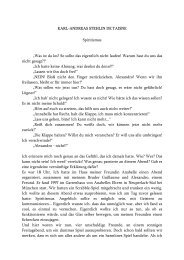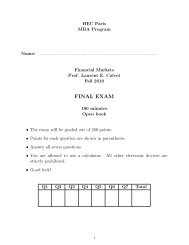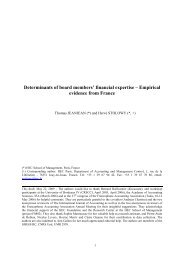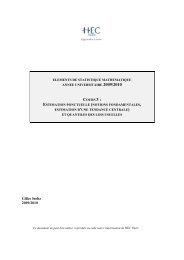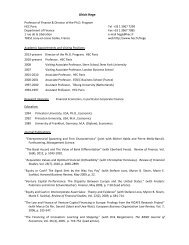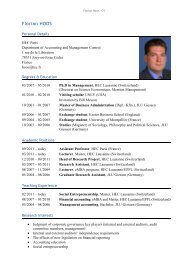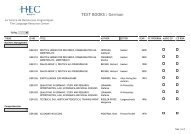Multifractality of US Dollar/Deutsche Mark Exchange Rates - Studies2
Multifractality of US Dollar/Deutsche Mark Exchange Rates - Studies2
Multifractality of US Dollar/Deutsche Mark Exchange Rates - Studies2
Create successful ePaper yourself
Turn your PDF publications into a flip-book with our unique Google optimized e-Paper software.
7.2 Consistency in Subsamples<br />
We split the twenty-four year sample span <strong>of</strong> FED1 into two separate twelve year samples, 1973 −<br />
1985, and 1985 − 1997. Figure 22 shows partition functions and Figure 23 shows estimated multi-<br />
fractal spectra. The results are very similar to full sample results, suggesting near stationarity in<br />
the model. This is an important result, and probably the most substantial test <strong>of</strong> robustness in<br />
DM/<strong>US</strong>D scaling.<br />
Also <strong>of</strong> interest is the small, but noticeable, difference between the two subsamples. The break<br />
point occurs in 1985, a major turning point in international monetary policy. In February <strong>of</strong> 1985,<br />
a concerted intervention by major central banks reversed appreciation <strong>of</strong> the dollar, and marked a<br />
shift from “near complete flexibility to a managed float” (Catte, et al., 1994). 40 Consistent with<br />
this institutional shift, we notice a longer tail in the spectrum <strong>of</strong> the earlier, less managed, period.<br />
7.3 Seasonal Adjustment Filters<br />
This section tests robustness <strong>of</strong> scaling in the high frequency data to different deseasonalizing<br />
methods. We use four additional seasonal adjustment filters. Briefly, SEAS1 adjusts by number<br />
<strong>of</strong> quotes received per fifteen minutes. Like the previously used SEAS2, this method is market-<br />
activity based. The other three methods simply remove slow (on average) trading times from the<br />
data, expanding remaining time so as to keep total time constant. These are crude deseasonalizing<br />
methods. Details <strong>of</strong> construction are in Appendix 9.2.<br />
Figure 20 shows graphs <strong>of</strong> the partition function around q = 2 for each new seasonal filter.<br />
Figure 21 shows partition functions for higher moments. For comparison with Figures 6 and 7, the<br />
format and aspect ratio are identical, and the high frequency plots are shown next to the same<br />
daily data as previously.<br />
All methods, except to some degree SEAS4, result in strongly linear partition functions.<br />
Crossover occurs at roughly the same point, again with the possible exception <strong>of</strong> SEAS4, which<br />
appears to have a later crossover. The slopes <strong>of</strong> all partition functions appear slightly lower than<br />
in Figure 7. The lower slope is pronounced for SEAS4. Lower slopes result in wider estimated<br />
upon lower variability in the ask series than in the bid-ask midpoint. It would be interesting to see whether the same<br />
effect is present in other currencies.<br />
40<br />
This shift is clearest when viewed from the perspective <strong>of</strong> international agreements. Individual countries varied<br />
with respect to their exchange rate policies from 1973-1985.<br />
29



